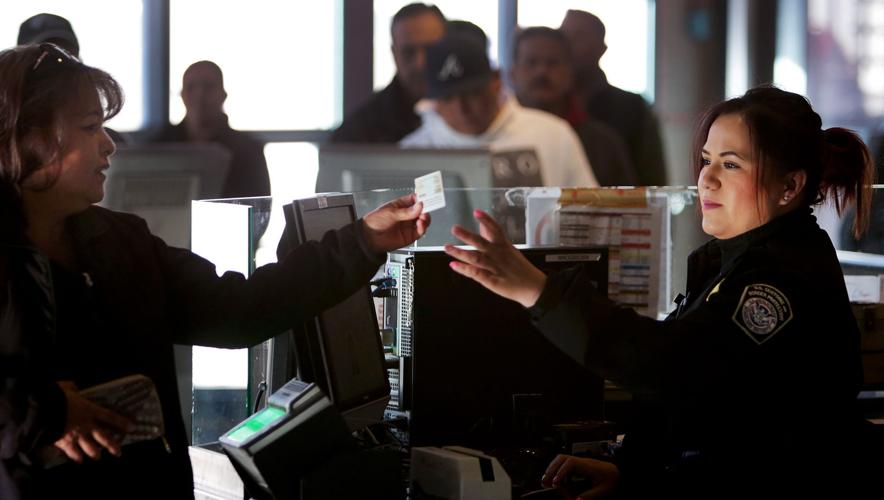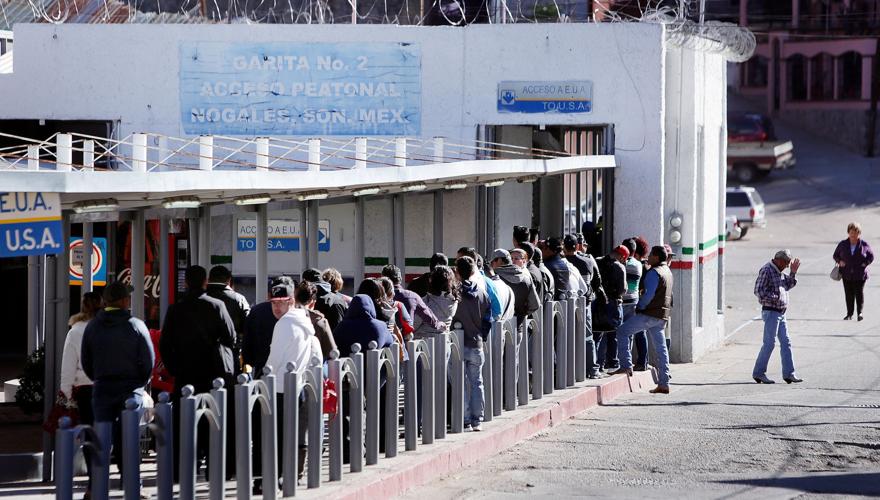The long-standing tactic of using fraudulent identification to sneak past customs officers appears to be on the decline.
Arrests for using documents that are fake, altered or belong to someone else fell nearly 80 percent in the last decade along the U.S.-Mexico border, according to U.S. Customs and Border Protection statistics obtained by the Star through a public-records request.
Customs officers working at ports of entry caught about 35,000 people using fraudulent documents in fiscal year 2007. Those busts fell to 7,200 by fiscal year 2016, CBP records show. At Arizona ports of entry, busts dropped by 60 percent during that period, from 2,600 to 1,050.
The cause for the decline in arrests is unclear, but CBP officials pointed to better law enforcement at ports and the introduction of high-tech identification documents in 2009 as contributing factors.
Making documents harder to counterfeit or pass off as belonging to someone else likely contributed to the decline, but fraudulent border crossers also could be changing their tactics or making fewer attempts in general, said Doris Meissner, senior fellow at the Migration Policy Institute, which researches immigration from a rights-based perspective.
Who’s crossing?
A review by the Star of 44 fraudulent-document cases in U.S. District Court in Tucson showed two basic categories: Mexican citizens trying to cross the border by themselves and U.S. citizens or legal permanent residents driving children across the border to be reunited with families in Chicago, Houston, Phoenix, Minneapolis and elsewhere.
Few details are available from cases involving Mexican citizens crossing the border by themselves, which usually last about a week and end with the defendant pleading guilty to a misdemeanor and sentenced to about three months in prison.
“They’re not any different than the people who cross through the desert,” said Tucson defense lawyer Saul M. Huerta.
Most people caught with fraudulent documents are trying to find work or reunite with relatives in the United States, he said.
Crossing through a port of entry is much less dangerous than crossing through the desert, Huerta said. He gave the example of a married couple splitting up, with the husband going through the desert and the wife taking the less-perilous route through a port of entry.
Court records show some of the people who use fraudulent documents live in cities in Mexico’s northern border region, like Nogales and Caborca.
However, many of the 44 cases reviewed by the Star show defendants reside in the Mexico City area and nearby states like Guanajuato, Jalisco, Michoacan, Morelos and Guerrero. Others come from southern Mexico states like Chiapas and Veracruz.
Altruism and profit
Brenda Leyva Felix, a 39-year-old Mexican citizen and legal permanent resident of the United States, was arrested last March at the downtown Nogales port after she claimed the 16-year-old boy in her van was her nephew.
She presented a Minnesota birth certificate on his behalf, but later admitted he was not her nephew and the birth certificate belonged to someone else. She was going to be paid $1,000 to smuggle the boy into the United States, according to the criminal complaint.
Leyva Felix pleaded guilty to a felony charge of conspiracy to transport an illegal alien for profit, but her attorney, Peter Raptis, disputed that she acted out of self-interest.
“Her motive was altruism, not money,” Raptis wrote in a sentencing memorandum.
Leyva Felix, who has no criminal history and is the mother of three children, drove the boy across the border as a favor to a co-worker in Minneapolis who had started crying at work, Raptis wrote.
Gangs were preying on the co-worker’s brother, who was caring for her son in Mexico. The co-worker’s brother rejected the gang’s attempts to recruit him and his family, which was met with assaults and the death of one family member.
After the boy was assaulted, the co-worker pleaded with Leyva Felix to bring him into the United States, Raptis wrote.
Leyva Felix had a history of dealing with violent situations, including sexual abuse and beatings as a young woman and later as a wife, Raptis wrote.
Recalling her own bleak past, she agreed to go to Nogales, Sonora, and drive the boy across the border. The $1,000 was meant to pay for the trip back to Minnesota.
“Her goal was to prevent the minor from suffering her own fate,” Raptis said.
Leyva Felix was sentenced Dec. 14 to three months in federal prison and three years probation.
“Impostor documents”
The majority of fraudulent document busts in the past decade — 85 percent in Arizona and 72 percent borderwide — involved what CBP calls “impostor documents.”
In these cases, someone uses passports, legal permanent resident cards or border-crossing cards — issued to border residents in Mexico that allow them to travel a short distance north of the border — that don’t belong to them.
Despite the risk of losing a valuable resource like a legitimate border-crossing document, renting them out is a long-standing practice, said Meissner, who headed the Immigration and Naturalization Service in the 1990s.
“People need to make money and there is always someone who is willing to take the risk,” she said.
Customs officers confiscate impostor documents and turn them over to either the issuing agency or CBP’s Fraudulent Document Analysis Unit, said CBP spokeswoman Teresa Small.
Fake and impostor documents can be bought on the streets of Nogales, Sonora, for as little as $50 to more than $500, Huerta said.
Impostor documents have the allure of being valid, and sellers tell travelers they are a sure-fire way to cross the border, Huerta said.
Although the new documents have made it difficult to fool customs officers, attempts will be made until land ports of entry have security similar to that at airports, Meissner said.
Before 2009, customs officers would accept any one of hundreds of identification documents from border crossers, including state IDs and birth certificates, according to Angelica De Cima, spokeswoman for CBP’s San Diego Field Office.
But the Western Hemisphere Travel Initiative reduced the number of acceptable documents to about six, all of which contain radio frequency identification chips that relay the traveler’s photo and other information to the customs officer, De Cima said.








